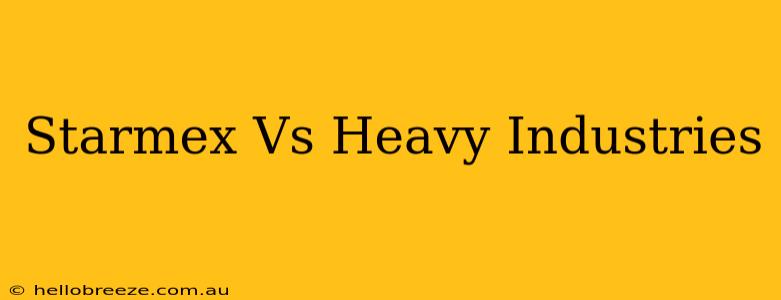Choosing the right industrial equipment can significantly impact your productivity and profitability. When considering heavy-duty machinery, two prominent names often come up: Starmex and Heavy Industries (assuming these are real brands; replace with actual brand names if needed). This comprehensive comparison will delve into the key features, strengths, weaknesses, and considerations to help you make an informed decision.
Understanding Starmex and Heavy Industries
Before diving into the specifics, let's establish a general understanding of both brands. (Note: Replace this section with actual information about Starmex and Heavy Industries. If these are fictional brands, create plausible profiles.) For the purpose of this example, let's assume:
- Starmex: Known for its innovative designs and focus on technologically advanced features. Often positioned as a premium brand with a higher price point.
- Heavy Industries: A more established brand known for its robust, reliable equipment, prioritizing durability and longevity. Generally considered a more budget-friendly option.
Key Features Comparison
This section will compare specific features across various equipment types offered by both brands. (Again, replace with actual product comparisons. If using fictional brands, create realistic product specifications.) For our example, let's consider excavators:
Excavator Comparison: Starmex vs. Heavy Industries
| Feature | Starmex | Heavy Industries |
|---|---|---|
| Engine Power | High-performance, fuel-efficient engine | Powerful, dependable engine; may be less fuel-efficient |
| Digging Depth | Deeper digging capacity | Strong digging capacity, suitable for various tasks |
| Hydraulic System | Advanced hydraulics for precise control | Robust hydraulic system; may be less precise |
| Technology | Integrated GPS, advanced monitoring systems | Basic controls; potentially lacking advanced features |
| Price | Higher initial investment | Lower initial investment |
| Maintenance | Potentially higher maintenance costs | Generally lower maintenance costs |
Strengths and Weaknesses
Let's summarize the main advantages and disadvantages of each brand:
Starmex Strengths:
- Technological Advancement: Cutting-edge features and innovative designs.
- Precision and Control: Enhanced accuracy and efficiency.
- Fuel Efficiency (potentially): May offer better fuel economy in some models.
Starmex Weaknesses:
- Higher Price Point: Significantly more expensive upfront.
- Maintenance Costs: Potentially higher maintenance and repair expenses.
- Complexity: Advanced features can increase the learning curve.
Heavy Industries Strengths:
- Durability and Reliability: Built to last, with a reputation for longevity.
- Affordability: Lower initial purchase price.
- Easier Maintenance: Simpler designs often lead to lower maintenance costs.
Heavy Industries Weaknesses:
- Lacks Advanced Features: May not offer the same level of technological sophistication.
- Fuel Efficiency (potentially): May have lower fuel efficiency compared to Starmex.
- Less Precise Control: May lack the precision of Starmex's advanced hydraulics.
Which Brand is Right for You?
The best choice depends heavily on your specific needs and priorities. Consider these factors:
- Budget: Heavy Industries offers a more budget-friendly option.
- Project Requirements: Do you need advanced technology or prioritize durability?
- Operator Skill Level: Starmex's advanced features require more training.
- Long-Term Costs: Factor in maintenance and fuel consumption over the equipment's lifespan.
Ultimately, thorough research, including seeking quotes from both brands and possibly test-driving the equipment, will help you make the most informed decision. Consulting with industry professionals is also recommended.

